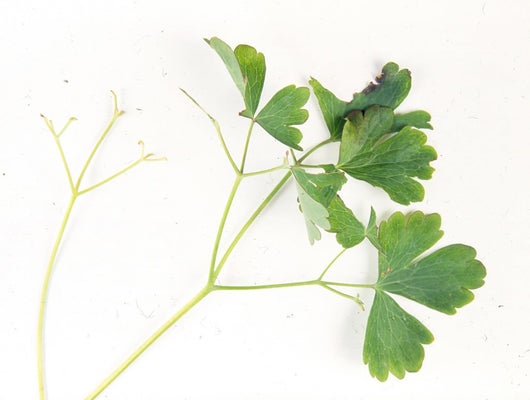
Quick facts
Common name - Aquilegia sawfly
Latin name - Pristiphora rufipes
Plants affected - Aquilegia
Main symptoms - Foliage is eaten by pale green caterpillar-like larvae
Caused by - Larvae of a sawfly
Timing - May-September
What is aquilegia sawfly?
Sawflies are a group of insects suborder (Symphyta) of the Hymenoptera (bees, ants and wasps). There are about 500 species of in Britain. They have caterpillar-like larvae that feed on plant material and are named after the saw-like egg laying organ used by females to lay eggs in plant material. Adults can come in a range of colours many are black, green orange or striped yellow and black. Most are small (< 1 cm) but some species such as the Birch sawfly (Cimbex femoratus) can be over 2 cm long. Several species can be found in gardens and are part of the a healthy garden will support. More information can be found at
Aquilegia sawfly larvae eat the leaves of aquilegia.
Symptoms
Aquilegia larvae feed in large groups and can defoliate aquilegia plants quickly. Watch for early signs from early May:
- Pale green caterpillar-like larvae with yellowish brown heads and up to 1 cm long. They feed on the edge of leaves whilst lying with most of the body beneath the leaf blade
- Complete defoliation can sometimes occur, plants usually recover
- The adult insect is a black, grey winged insect about 5 mm in length
Management
Sawflies are a part the a healthy garden supports.
- Where possible tolerate populations of aquilegia , plants often recover from defoliation and may not be affected every year
- Encourage predators and other natural enemies of sawfly in the garden, such as birds , wasps and ground beetles
- Check plants regularly from May for the presence of larvae to prevent a damaging population developing
- Remove by hand if required and where practical
Biology
Adult aquilegia are black-bodied insects, up to 5.5 mm long, with two pairs of blackish grey wings and light brown legs. They appear similar to small flies but are in the same order of insects as bees, ants and wasps, the Hymenoptera. They emerge in late spring.
The larvae feed on the underside of the leaves, making large holes from the leaf edge. They take about two weeks to complete development before entering the soil to pupate. Adults emerge from the pupa after a couple of weeks and soon lay eggs. A second generation of larvae can then cause more defoliation. By mid-summer, the stems may have been stripped of foliage, plants will usually recover. Larvae of the second generation overwinter in pupal cocoons in the soil.













